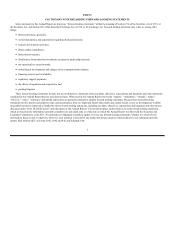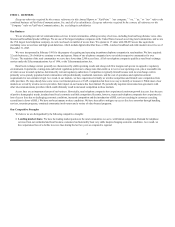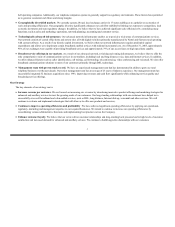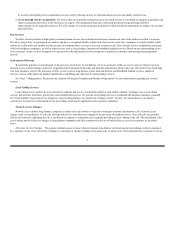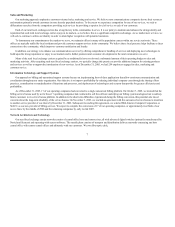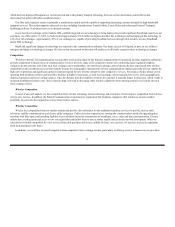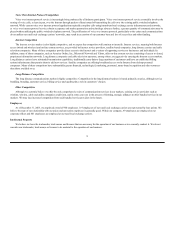FairPoint Communications 2005 Annual Report Download - page 12
Download and view the complete annual report
Please find page 12 of the 2005 FairPoint Communications annual report below. You can navigate through the pages in the report by either clicking on the pages listed below, or by using the keyword search tool below to find specific information within the annual report.
The following summary does not describe all present and proposed federal, state and local legislation and regulations affecting the communications
industry. Some legislation and regulations are currently the subject of judicial proceedings, legislative hearings and administrative proposals which could
change the manner in which this industry operates. Neither the outcome of any of these developments, nor their potential impact on us, can be predicted at this
time. Regulation can change rapidly in the communications industry, and such changes may have an adverse effect on us in the future. See “Item 7.
Management’s Discussion and analysis of Financial Condition and Results of Operations—Risk Factors—Risks Related to our Regulatory Environment.”
Our regulated communications services are subject to extensive federal, state and local regulation. We hold various regulatory authorizations for our
service offerings. At the federal level, the Federal Communications Commission generally exercises jurisdiction over all facilities and services of
communications common carriers, such as us, to the extent those facilities are used to provide, originate, or terminate interstate or international
communications. State regulatory commissions generally exercise jurisdiction over such facilities and services to the extent those facilities are used to provide,
originate or terminate intrastate communications. In addition, pursuant to the Telecommunications Act, state and federal regulators share responsibility for
implementing and enforcing the domestic pro-competitive policies introduced by that legislation. In particular, state regulatory agencies have substantial
oversight over the provision by incumbent telephone companies of interconnection and non-discriminatory network access to competitive communications
providers. Local governments often regulate the public rights-of-way necessary to install and operate networks, and may require communications services
providers to obtain licenses or franchises regulating their use of public rights-of-way. Additionally, municipalities and other local government agencies may
regulate limited aspects of our business, including our use of public rights of way, and by requiring us to obtain construction permits and abide by building
codes.
We believe that competition in our telephone service areas will increase in the future as a result of the Telecommunications Act and through increased
deployment of various types of technology, although the ultimate form and degree of competition cannot be ascertained at this time. Competition may lead to
loss of revenues and profitability as a result of: loss of customers; reduced usage of our network by our existing customers who may use alternative providers
for long distance, voice and data services; and reductions in prices for our services which may be necessary to meet competition.
Federal Regulation
We must comply with the Communications Act which requires, among other things, that communications carriers offer services at just and reasonable
rates and on non-discriminatory terms and conditions. The amendments to the Communications Act contained in the Telecommunications Act dramatically
changed and are expected to continue to change the landscape of the communications industry. The central aim of the Telecommunications Act was to open
local communications marketplaces to competition while enhancing universal service. Most significantly, the Telecommunications Act governs the removal of
barriers to market entry into local telephone services, requires incumbent local exchange carriers to interconnect with competitors, establishes procedures
pursuant to which incumbent local exchange carriers may provide other services, such as the provision of long distance services by regional bell operating
companies, and imposes on incumbent local exchange carriers duties to negotiate interconnection arrangements in good faith.
10



